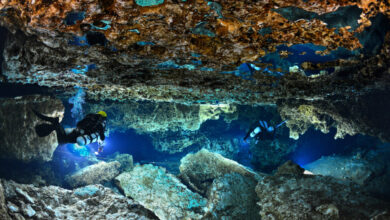Massive Pre-Historic Mega Structure That CAN NOT Be Explained
The ancient site is located in the **Bekaa Valley, Lebanon**, where the giant megalithic structures defy conventional archaeological understanding.

—
#### **Location and scale**
– Baalbek is located about 60 miles** from **Beirut** and sits on a sacred hill **3,000 feet** (~914 meters) high.
**Before the Romans** built the **Temple of Jupiter**, Baalbek had a foundation made of giant stone blocks considered the **largest in the world**.
—
#### **The Trilithons and the giant foundation**
– **Trilithons**: These are **19m** long** blocks, **4.2m** high**, **3.6m** thick**, weighing **about 900 tons** each. – These large blocks are **36 times** heavier** than those of **Stonehenge** and **10 times** heavier** than the largest block of the **Giza Pyramid**.
– Although the blocks were **quarried more than half a mile away**, they were transported and stacked up to **30 feet** high on smaller blocks (weighing **400 tons**). This is puzzling because **Roman engineering was not capable** of moving or lifting such large blocks.
– In particular, the stones are **so tightly packed** that a sheet of paper cannot be inserted between them.
—
#### **Differences with Roman architecture**
– The **trilithons are buried in the ground**, hidden from view, and are not decorative like Roman structures, but appear to have served **a structural purpose**.
– **There are no Roman documents** recording the movement and installation of the trilithons. The **Roman cranes** could only lift a maximum of **60 tonnes**, while the trilithon weighs **900 tonnes** and has **no lewis holes** (holes for lifting tools).
– The distinct difference between the **sophisticated foundation architecture** and the **more primitive Roman structure** suggests that Baalbek may have gone through **several stages of development**, with the earliest stage being more technically advanced.

#### **Traces of modern technology?**
– On the surface of the stones at Baalbek there are **3m long scratches**, completely **parallel**, which appear to have been made by **machinery**. These marks also appear at the **Yangshan mine in China** and **Petra in Jordan** – ancient sites of enormous structures. – These traces **resemble the cuts of modern mining equipment**, suggesting that ancient technology may have reached a level **equivalent to modern technology**.
—
#### **Hypothesis of advanced civilization**
– Many researchers, such as **Graham Hancock**, believe that these trilithons may be **12,000 years old**, which is **about 10,000 years earlier than Rome**.
– In addition, **signs of continuous habitation from 9000 BC** have been found at Baalbek, suggesting that **an unknown civilization** once existed and built this structure.
—
#### **Hidden blocks and new discoveries**
– To the south of the **Temple of Jupiter**, there is a **megalithic wall** with blocks of stone **weighing 800 tons**, so tightly fitted that it is difficult to see the joints between them. Most of these blocks remain **buried underground**, unexcavated.
– The large **Roman** columns at Jupiter’s Temple are **20m** high and are made up of several sections. Although they are excellent examples of Roman engineering, they are no match for the ancient foundations.
– Archaeologists have also discovered **older columns** nearby, but most have been destroyed, suggesting that **civilizations earlier than the Romans** left their mark at Baalbek.
—
**Conclusion**
– Baalbek suggests the existence of **a superior ancient civilization**, using advanced technology that we do not yet fully understand. The Roman structures are only the **outer covering**, while the deeper megalithic foundations may have existed **thousands of years ago**. – Baalbek is powerful evidence that **human history may be more complex and profound** than we currently know.
1. **Pink Granite Columns from Aswan**:
– The columns at Baalbek were not made from local limestone like other Roman structures, but from rose granite – a very hard stone.
– The stone was quarried from a quarry in Aswan, more than 1,100 km from Baalbek, and this was also the source of the stone for the Pharaoh’s Chamber in the Great Pyramid of Giza.
– Each column is a single block, not made up of many parts, weighing up to 80 tons.
2. **Transportation over difficult terrain**:
– Transporting the columns from Aswan to Baalbek was more complicated than transporting the stones to Giza.
– The columns had to be carried over the Lebanon Mountains, with an average elevation of 2,500 metres (8,200 feet).
– This raises questions about what technology was used, as there is no evidence that ancient civilizations had this ability.
3. **Challenges in Granite Processing**:
– Granite is very difficult to process and can only be cut accurately with diamond-tipped tools – which only appeared in the 19th century.
– The Baalbek columns have a smooth, polished surface with high precision, without any small defects such as dents or scratches, despite being thousands of years old.
4. **Signs of advanced technology**:
– Strange marks found on broken pieces of stone and large granite blocks in the area suggest that these blocks may have been cut by machines.
– Many blocks show signs of iron oxidation, indicating the use of metal tools – something far beyond the capabilities of ancient times.
5. **Possible disaster**:
– Many parts of the structure and columns are broken into pieces, as if they were affected by a terrible disaster.
– Researcher Brien Foerster, who has written a book about Baalbek, believes that the cut marks on the stone are evidence of advanced technology that modern humans do not fully understand.
6. **Giant Stones in the Baalbek Quarry**:
– The Baalbek Quarry, about a mile from the main temple, is where large stones were mined, such as:
– *”Stone of the Pregnant Woman”*: 68 feet long (about 21 meters), weighing more than 1,200 tons.
– *”Forgotten Stone”*: Discovered in 2014, weighing 1,650 tons, the largest stone ever mined in the world.
– These stones lie on their sides in the quarry, suggesting that the mining process was stopped abruptly, possibly due to a catastrophic event.
7. **Ritual and Astronomical Traces**:
– The standing stones at the quarry are called *“Witnesses”*, which may have been symbolic markers or tools used in ancient rituals.
– Some researchers believe that these stones may be related to astronomical signs, similar to Stonehenge in England or Karnak in France.
8. **Baalbek Hypothesis**:
– According to legend, Baalbek was built by Cain, son of Adam, 133 years after the creation of mankind, with the help of the Nephilim giants.
– These giants were punished with the Great Flood for their sins.
9. **Conclusion and Future Explorations**:
– The techniques used to quarry, transport and install the large stones are beyond the capabilities of any civilization we know of.
– The road to Baalbek is rough and steep, with no evidence of a flat surface large enough to drag the stones. Even with pulley systems, there is no suitable space for installation.
– The quarry has not yet been fully excavated, and new discoveries may shed more light on prehistoric civilizations.
**Conclusion**:
– The structures at Baalbek remain a great mystery, leaving both scientists and the public curious about ancient civilizations and their technological capabilities beyond their time.








